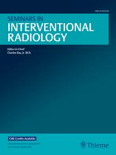
SEMINARS IN INTERVENTIONAL RADIOLOGY
Scope & Guideline
Navigating the Landscape of Interventional Radiology
Introduction
Aims and Scopes
- Interventional Oncology:
A significant focus is on interventional oncology, particularly the treatment of liver cancers and other malignancies using techniques such as radioembolization, ablation, and chemoembolization. - Imaging Techniques and Innovations:
The journal emphasizes advancements in imaging modalities that enhance interventional procedures. This includes the use of contrast-enhanced ultrasound, cone beam computed tomography, and other imaging technologies that support targeted interventions. - Guidelines and Protocol Standardization:
It publishes consensus guidelines and standardization protocols for various interventional procedures, ensuring that practitioners have access to the best practices in the field. - Minimally Invasive Techniques:
The journal showcases minimally invasive techniques across various specialties, focusing on their application in treating conditions such as vascular disease, tumors, and pain management. - Patient Safety and Outcomes:
Research on optimizing patient outcomes and safety during interventional procedures is a recurring theme, reflecting the journal's commitment to evidence-based practices. - Emerging Therapies and Techniques:
The exploration of new therapies and technologies, including robotic assistance and novel embolic agents, is a vital component of the journal's aims.
Trending and Emerging
- Image-Guided Procedures:
There is a marked increase in publications focused on image-guided procedures, highlighting the importance of imaging in enhancing the precision and effectiveness of interventional techniques. - Robotic and Automated Techniques:
The exploration of robotic assistance in interventional procedures is gaining traction, reflecting an industry trend towards automation and improved procedural efficiency. - Therapeutic Embolization Innovations:
Innovations in therapeutic embolization techniques, including the development of new embolic materials and applications, are increasingly featured, indicating a growing interest in this area. - Patient-Centric Approaches:
There is a rising focus on patient safety, satisfaction, and outcomes, suggesting a shift towards more patient-centered care practices within interventional radiology. - Integration of Artificial Intelligence:
The incorporation of artificial intelligence (AI) in interventional radiology is emerging as a significant theme, with research exploring its potential to enhance imaging, decision-making, and procedural outcomes.
Declining or Waning
- Traditional Surgical Techniques:
There appears to be less emphasis on traditional surgical techniques as interventional radiology increasingly adopts minimally invasive approaches. Discussions around open surgical procedures have diminished. - General Vascular Surgery Topics:
The journal has shifted away from broader vascular surgery topics, concentrating more on specialized interventional techniques rather than general surgical approaches to vascular diseases. - Historical Perspectives:
There has been a decrease in articles focused on historical perspectives and reflections on the evolution of interventional radiology, with more emphasis placed on contemporary practice and future directions. - Non-Interventional Radiology Topics:
Themes unrelated directly to interventional radiology, such as general medical ethics or non-procedural aspects of patient care, have been less frequently addressed, suggesting a tightening of the journal's focus.
Similar Journals
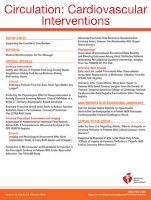
Circulation-Cardiovascular Interventions
Transforming Research into Real-World Cardiovascular Solutions.Circulation-Cardiovascular Interventions, published by LIPPINCOTT WILLIAMS & WILKINS, is a premier journal in the field of cardiology and cardiovascular medicine, recognized for its commitment to advancing the understanding and treatment of cardiovascular diseases. With a robust Impact Factor and ranking in the top 10% of its category, it serves as an essential resource for researchers, clinicians, and students seeking to stay at the forefront of cardiovascular intervention developments. This esteemed journal covers a range of topics, including innovative therapeutic strategies, cutting-edge clinical trials, and comprehensive reviews that inform clinical practice and influence guidelines. Since its inception in 2008, and extending through 2024, Circulation-Cardiovascular Interventions has published pivotal research that shapes the landscape of cardiovascular care in the United States and beyond. Its commitment to high-quality publications makes it an invaluable platform for sharing knowledge and fostering collaboration within the global medical community.

EUROPEAN RADIOLOGY
Your Gateway to the Latest in RadiologyEUROPEAN RADIOLOGY, published by SPRINGER, stands as a prestigious international journal in the field of radiology, nuclear medicine, and imaging, with an impressive impact factor that underscores its significance among peers. With an ISSN of 0938-7994 and an E-ISSN of 1432-1084, this journal provides a platform for cutting-edge research and advancements in medical imaging from 1991 to 2024. Recognized as a Q1 journal in both general Medicine and the specialized Radiology category by 2023, EUROPEAN RADIOLOGY ranks an impressive #17 out of 333 in its field according to Scopus, placing it in the 95th percentile. While it does not currently offer Open Access options, the journal remains essential reading for researchers, professionals, and students striving to stay at the forefront of developments in diagnostic imaging and related technologies. By contributing to a comprehensive understanding of radiological practices, EUROPEAN RADIOLOGY plays a crucial role in shaping the future of medical diagnosis and patient care.
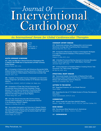
JOURNAL OF INTERVENTIONAL CARDIOLOGY
Leading the Charge in Interventional Cardiology Discoveries.JOURNAL OF INTERVENTIONAL CARDIOLOGY, published by Wiley-Hindawi, stands as a pivotal resource in the dynamic fields of Cardiology and Cardiovascular Medicine, as well as Radiology, Nuclear Medicine, and Imaging. With an esteemed Q2 ranking in both categories as of 2023, this journal fosters the dissemination of innovative findings and methodologies in interventional cardiology, bridging the gap between clinical practice and research. Since transitioning to Open Access in 2019, it enhances accessibility and encourages a broader reach for its audience of researchers, professionals, and students. With a wide-ranging scope that extends from its inception in 1988 through to 2024, the journal continually captures significant advancements and trends within the cardiovascular arena, ensuring it remains an essential tool for ongoing education and professional development.

JOURNAL OF INVASIVE CARDIOLOGY
Leading the Conversation in Invasive CardiologyJOURNAL OF INVASIVE CARDIOLOGY, a reputable publication by H M P COMMUNICATIONS, is dedicated to advancing the field of cardiology and cardiovascular medicine through rigorous research and scholarly discussion. With an ISSN of 1042-3931 and an E-ISSN of 1557-2501, this journal serves as a crucial resource for healthcare professionals, researchers, and students who seek to stay informed about the latest findings and innovations in invasive cardiology. Having achieved a 2023 Scopus rank of #185 out of 636 in General Medicine, placing it in the 70th percentile, the journal is recognized for its significant contributions to medical science, evidenced by its Q2 ranking in Radiology, Nuclear Medicine and Imaging, and Q3 status in both Cardiology and Cardiovascular Medicine. The journal has been in circulation since 1990 and continues to foster a platform for critical research in the United States, ensuring accessibility to vital information necessary for enhancing patient care and clinical practices within the domain of invasive procedures.
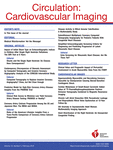
Circulation-Cardiovascular Imaging
Transforming diagnostics with cutting-edge imaging research.Circulation-Cardiovascular Imaging is a prestigious journal published by LIPPINCOTT WILLIAMS & WILKINS, dedicated to advancing the field of cardiovascular imaging through high-quality research and review articles. With an impact factor placing it in the Q1 category across key areas including Cardiology and Cardiovascular Medicine, Medicine (miscellaneous), and Radiology, Nuclear Medicine and Imaging, this journal fosters scholarly communication among leading experts and emerging researchers. Established in 2008, it has rapidly become an essential resource for academics and professionals, given its commitment to disseminating groundbreaking findings and methodologies that influence clinical practices and patient outcomes. Circulation-Cardiovascular Imaging is designed to engage a wide audience, from seasoned practitioners to students keen on exploring the nexus of cardiology and innovative imaging techniques. Its significant visibility in the medical literature underscores its role as a cornerstone in the evolution of cardiovascular diagnostics and patient care.

Insights into Imaging
Connecting Researchers and Practitioners in ImagingInsights into Imaging is a prominent open-access journal published by SPRINGER WIEN, specializing in the dynamic fields of radiology, nuclear medicine, and imaging, with its ISSN 1869-4101. Established in 2012, the journal has established itself as a leading platform for disseminating high-quality research and innovative findings, currently holding a prestigious Q1 ranking in its category as of 2023. With an impressive Scopus rank of #42 out of 333 in the medicine discipline, the journal is positioned in the 87th percentile, reflecting its significance and influence in the academic community. Based in Germany, Insights into Imaging not only provides unrestricted access to research but also aims to bridge the gap between scientific inquiry and clinical application, making it an essential resource for researchers, professionals, and students engaged in advancing imaging technologies and practices. The journal’s commitment to fostering knowledge exchange ensures that it remains a critical contributor to the evolving landscape of medical imaging, with articles available from 2012 through 2024.

SA Journal of Radiology
Advancing Radiology: Bridging Knowledge and InnovationThe SA Journal of Radiology is a prominent open-access journal published by AOSIS, dedicated to advancing knowledge in the fields of Radiology and Ultrasound Technology. Established in 2004, this South African journal provides a platform for researchers, professionals, and students to disseminate valuable findings and share innovative practices in medical imaging. With an ISSN of 1027-202X and an E-ISSN of 2078-6778, the journal has become an important resource for those involved in radiological sciences, despite currently holding a Q4 ranking in both Radiological and Ultrasound Technology and Radiology, Nuclear Medicine and Imaging categories. Covering a converged time span from 2014 to 2024, the journal aims to promote scholarly communication and enhance the accessibility of research, positioning itself as a key player in the global radiological community. In a landscape where open access is increasingly critical, the SA Journal of Radiology is committed to fostering research collaboration and facilitating the exchange of ideas among clinicians and academics alike.
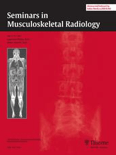
SEMINARS IN MUSCULOSKELETAL RADIOLOGY
Pioneering the Path in Musculoskeletal RadiologySEMINARS IN MUSCULOSKELETAL RADIOLOGY is a leading journal in the fields of Orthopedics and Sports Medicine, as well as Radiology, with a strong emphasis on advancing the understanding and application of imaging techniques in musculoskeletal disorders. Published by THIEME MEDICAL PUBL INC, this esteemed journal boasts a reputation for high-quality, peer-reviewed articles that span essential topics ranging from diagnostic imaging methods to innovative therapeutic strategies. With its ISSN 1089-7860 and E-ISSN 1098-898X, the journal is a vital resource for researchers, clinicians, and students eager to stay updated on the latest developments in musculoskeletal imaging. Notably positioned in the Q3 category for both Orthopedics and Sports Medicine and Radiology, Nuclear Medicine and Imaging, it serves as an essential platform for sharing pioneering research and clinical practices that enhance patient care. Operating in a traditionally challenging landscape for publication access, its focus remains on rich, impactful content that resonates with the academic community, despite currently non-open access delivery. Since its inception in 1999, the journal has endured, adapting to the ever-evolving medical landscape and continues to contribute significantly to the scientific body of knowledge through 2024 and beyond.
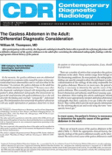
Contemporary Diagnostic Radiology
Exploring the Future of Imaging TechniquesContemporary Diagnostic Radiology is a pivotal journal in the field of medical imaging and radiology, published by Lippincott Williams & Wilkins. With an ISSN of 0149-9009 and an E-ISSN of 1938-1395, this journal serves as an essential platform for disseminating high-quality research and advances in diagnostic radiology and related disciplines. While it is categorized in the lower quartiles (Q4) for its performance in the 2023 rankings in both Neurology, Radiology, Nuclear Medicine and Imaging, and Surgery, its focus on emerging technologies and methodologies in imaging continues to provide valuable insights for practitioners and researchers alike. The journal’s scope includes innovative diagnostic tools, imaging techniques, and case studies, fostering collaboration and knowledge sharing in the medical community. Although it does not offer open access options, its commitment to contributing to the ongoing dialogue in clinical imaging is undisputed, making it an essential resource for professionals seeking to stay abreast of current trends and research in the rapidly evolving landscape of diagnostic radiology.

Iranian Journal of Radiology
Transforming Radiology with Cutting-Edge StudiesWelcome to the Iranian Journal of Radiology, a pivotal platform dedicated to advancing the field of radiology, nuclear medicine, and medical imaging. Published by BRIEFLAND, this journal aims to disseminate high-quality original research, reviews, and clinical studies that contribute substantially to the global scientific community. Established in 2008 and spanning until 2024, the journal provides an essential archive of knowledge in a rapidly evolving discipline. Although it currently holds a Q4 quartile ranking in the 2023 Scopus metrics, it serves as an important resource for both emerging and established researchers looking to submit their work. Located in the Netherlands, the journal is committed to open dialogue and collaboration amongst professionals in the field, reflecting its accessibility and relevance to both practitioners and academics. With its continued growth and commitment to quality, the Iranian Journal of Radiology is poised to enhance understanding and innovation in diagnostic imaging.